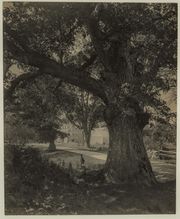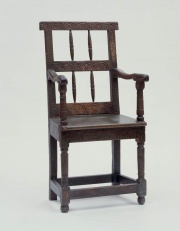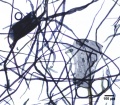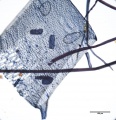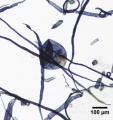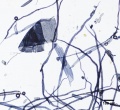Difference between revisions of "Oak"
| (19 intermediate revisions by 2 users not shown) | |||
| Line 1: | Line 1: | ||
| − | [[File:21.13-SC14474.jpg|thumb| | + | [[File:Wayside Inn Oak.jpg|thumb|Waside Inn Oak <br>MFA# 2018.179]] |
| + | [[File:21.13-SC14474.jpg|thumb|Bokk Harmoinum<br>MFA# 21.13]] | ||
== Description == | == Description == | ||
| − | Common hardwood trees of the family Fagaceae and genus ''Quercus'' that are widespread throughout the northern temperate zones. Oaks produce a durable wood that has a distinctive coarse grain | + | Common hardwood trees of the family Fagaceae and genus ''Quercus'' that are widespread throughout the northern temperate zones. Oaks, with over 600 species, typically range in size from shrubs to 30m with girths measure 1-1.5m. Oaks have spirally arrange leaves with multiple lobes and smooth margins. The fruit is called an acorn, a small nut, that is polular with squirrels. Oak trees produce a durable wood that is resistant to insect damage due to its high tannin content. The timber has a distinctive coarse grain and has been used for centuries in construction, cabinetry, flooring, paneling, musical instruments, ship interiors, and moldings. It was used for panel paintings in the Netherlands, England, Germany and northern France until the 18th century (Kuhn 1986). During the gothic period, oak was also used for sculptures in the northern parts of Germany, France and western Belgium (Kuhn, 1986), The thick bark from the cork oak tree (''Quercus suber'') is used for its buoyancy. Tannins and dyes can be extracted from the bark of oak trees. Oak [[gall|galls]] were used to produce [[iron gall ink]]. |
| − | See | + | See [[black oak]], [[blue oak]], [[bog oak]], [[cork oak]], [[English oak]], [[live oak]], [[northern red oak]], [[pin oak]], [[red oak]], [[scarlet oak]], [[shingle oak]], [[white oak]]. |
| + | |||
| + | * See also [[http://cameo.mfa.org/wiki/Category:Uemura_dye_archive '''Uemera Dye Archive''' (Kunugi)]] | ||
| + | [[File:64.127-E3177CR-d1.jpg|thumb|Carved oak armchair<br>MFA# 64.127]] | ||
| − | |||
== Synonyms and Related Terms == | == Synonyms and Related Terms == | ||
''Quercus''; oake; eg (Dan.); Eichen (Deut.); roble (Esp.); chêne (Fr.); quercia (It.); eik (Ned., Nor.); carvalho roble (Port.); Ekar (Sven.) | ''Quercus''; oake; eg (Dan.); Eichen (Deut.); roble (Esp.); chêne (Fr.); quercia (It.); eik (Ned., Nor.); carvalho roble (Port.); Ekar (Sven.) | ||
| + | ==Collection Risks == | ||
| + | |||
| + | Oak emits organic acids as it ages. | ||
| + | ==Physical and Chemical Properties== | ||
| − | = | + | Wood Density = 37-56 ppcf |
| − | |||
| − | |||
| − | |||
| − | |||
| − | |||
Paper fiber type: hardwood, ring porous. Using transmitted light microscopy, pulp is identified by two sizes of vessels with profuse pitting. The smaller late wood vessels of [[red oak]] will stain darker than the early wood vessels, which can help distinguish pulp from [[white oak]]. Vasocentric tracheids are worm-like and heavily pitted. Perforations are simple. Tyloses are present in [[white oak]]. Appearance with [[Graff "C" stain]]: dark blue, but varies with bleaching. Average dimensions of fibers: length 1.47mm, 14-22μm wide. Common pulping method: [[kraft process|kraft]]. | Paper fiber type: hardwood, ring porous. Using transmitted light microscopy, pulp is identified by two sizes of vessels with profuse pitting. The smaller late wood vessels of [[red oak]] will stain darker than the early wood vessels, which can help distinguish pulp from [[white oak]]. Vasocentric tracheids are worm-like and heavily pitted. Perforations are simple. Tyloses are present in [[white oak]]. Appearance with [[Graff "C" stain]]: dark blue, but varies with bleaching. Average dimensions of fibers: length 1.47mm, 14-22μm wide. Common pulping method: [[kraft process|kraft]]. | ||
| − | == | + | == Working Properties == |
| − | |||
| − | |||
| − | |||
| − | |||
| − | |||
| − | |||
| − | + | The characteristics for different species can vary widely. Red oak(''Quercus rubra'') displays large open pores, while white oak has a tightly closed formation. White oak (''Quercus alba'') also resist mosture and decay , which makes it useful for outdoor furniture and boats. The hard wood is also widely used for table, chairs, floors, trim and turnings. Because of its density, white oak dictates a slow feed rate for ripping. Both types of oak are susceptible to splintering, or loss of chips. The high tannic acid in oak can turn screw black, that in turn stain the wood. | |
== Additional Images == | == Additional Images == | ||
| Line 39: | Line 35: | ||
Whiteoak tyloses 10x.jpg|White oak paper pulp stained with Graff "C" stain | Whiteoak tyloses 10x.jpg|White oak paper pulp stained with Graff "C" stain | ||
Whiteoak 10x.jpg|White oak paper pulp stained with Graff "C" stain | Whiteoak 10x.jpg|White oak paper pulp stained with Graff "C" stain | ||
| + | Uemura 07-23-2009 247.jpg|Silk dyed with acorns, Uemera Dye Archive | ||
</gallery> | </gallery> | ||
| − | == | + | == Resources and Citations == |
| + | * Alden Identification Services, Microscopic Wood Identification: [https://wood-identification.com/wood-types/ Link] | ||
| + | |||
| + | * H.Kuhn, ''Conservation and Restoration of Works of Art and Antiquities'', Butterworths, London, 1986. | ||
| + | |||
| + | * Schoch, W., Heller, I., Schweingruber, F.H., Kienast, F., 2004:[http://www.woodanatomy.ch/ Wood anatomy of central European Species]: Pedunculate Oak,[http://www.woodanatomy.ch/species.php?code=QURO Quercus robur L.] | ||
| + | |||
| + | * Wikipedia: http://en.wikipedia.org/wiki/Oak (Accessed Oct. 8, 2005 and April 2020) | ||
* G.S.Brady, ''Materials Handbook'', McGraw-Hill Book Co., New York, 1971 Comment: p. 555 | * G.S.Brady, ''Materials Handbook'', McGraw-Hill Book Co., New York, 1971 Comment: p. 555 | ||
| − | |||
| − | |||
* F. H. Titmuss, ''Commercial Timbers of the World'', The Technical Press Ltd., London, 1965 Comment: 40-50 ppcf | * F. H. Titmuss, ''Commercial Timbers of the World'', The Technical Press Ltd., London, 1965 Comment: 40-50 ppcf | ||
| − | * ''Encyclopedia Britannica'', http://www.britannica.com Comment: "oak" | + | * ''Encyclopedia Britannica'', http://www.britannica.com Comment: "oak" [Accessed October 24, 2001] |
| − | |||
| − | |||
* R. J. Gettens, G.L. Stout, ''Painting Materials, A Short Encyclopaedia'', Dover Publications, New York, 1966 | * R. J. Gettens, G.L. Stout, ''Painting Materials, A Short Encyclopaedia'', Dover Publications, New York, 1966 | ||
Revision as of 10:33, 4 October 2020
Description
Common hardwood trees of the family Fagaceae and genus Quercus that are widespread throughout the northern temperate zones. Oaks, with over 600 species, typically range in size from shrubs to 30m with girths measure 1-1.5m. Oaks have spirally arrange leaves with multiple lobes and smooth margins. The fruit is called an acorn, a small nut, that is polular with squirrels. Oak trees produce a durable wood that is resistant to insect damage due to its high tannin content. The timber has a distinctive coarse grain and has been used for centuries in construction, cabinetry, flooring, paneling, musical instruments, ship interiors, and moldings. It was used for panel paintings in the Netherlands, England, Germany and northern France until the 18th century (Kuhn 1986). During the gothic period, oak was also used for sculptures in the northern parts of Germany, France and western Belgium (Kuhn, 1986), The thick bark from the cork oak tree (Quercus suber) is used for its buoyancy. Tannins and dyes can be extracted from the bark of oak trees. Oak galls were used to produce Iron gall ink.
See Black oak, Blue oak, Bog oak, Cork oak, English oak, Live oak, Northern red oak, Pin oak, Red oak, Scarlet oak, Shingle oak, White oak.
- See also [Uemera Dye Archive (Kunugi)]
Synonyms and Related Terms
Quercus; oake; eg (Dan.); Eichen (Deut.); roble (Esp.); chêne (Fr.); quercia (It.); eik (Ned., Nor.); carvalho roble (Port.); Ekar (Sven.)
Collection Risks
Oak emits organic acids as it ages.
Physical and Chemical Properties
Wood Density = 37-56 ppcf
Paper fiber type: hardwood, ring porous. Using transmitted light microscopy, pulp is identified by two sizes of vessels with profuse pitting. The smaller late wood vessels of Red oak will stain darker than the early wood vessels, which can help distinguish pulp from White oak. Vasocentric tracheids are worm-like and heavily pitted. Perforations are simple. Tyloses are present in White oak. Appearance with Graff "C" stain: dark blue, but varies with bleaching. Average dimensions of fibers: length 1.47mm, 14-22μm wide. Common pulping method: kraft.
Working Properties
The characteristics for different species can vary widely. Red oak(Quercus rubra) displays large open pores, while white oak has a tightly closed formation. White oak (Quercus alba) also resist mosture and decay , which makes it useful for outdoor furniture and boats. The hard wood is also widely used for table, chairs, floors, trim and turnings. Because of its density, white oak dictates a slow feed rate for ripping. Both types of oak are susceptible to splintering, or loss of chips. The high tannic acid in oak can turn screw black, that in turn stain the wood.
Additional Images
Resources and Citations
- Alden Identification Services, Microscopic Wood Identification: Link
- H.Kuhn, Conservation and Restoration of Works of Art and Antiquities, Butterworths, London, 1986.
- Schoch, W., Heller, I., Schweingruber, F.H., Kienast, F., 2004:Wood anatomy of central European Species: Pedunculate Oak,Quercus robur L.
- Wikipedia: http://en.wikipedia.org/wiki/Oak (Accessed Oct. 8, 2005 and April 2020)
- G.S.Brady, Materials Handbook, McGraw-Hill Book Co., New York, 1971 Comment: p. 555
- F. H. Titmuss, Commercial Timbers of the World, The Technical Press Ltd., London, 1965 Comment: 40-50 ppcf
- Encyclopedia Britannica, http://www.britannica.com Comment: "oak" [Accessed October 24, 2001]
- R. J. Gettens, G.L. Stout, Painting Materials, A Short Encyclopaedia, Dover Publications, New York, 1966
- Caring for your Collections, Arthur W Schulz (ed.), Harry N. Abrams, Inc. , New York, 1992
- Van Nostrand's Scientific Encyclopedia, Douglas M. Considine (ed.), Van Nostrand Reinhold, New York, 1976
- The American Heritage Dictionary or Encarta, via Microsoft Bookshelf 98, Microsoft Corp., 1998
- CRC Handbook of Chemistry and Physics, Robert Weast (ed.), CRC Press, Boca Raton, Florida, v. 61, 1980 Comment: density=37-56 ppcf (0.60-0.90 g/cm3)
- Marja-Sisko Ilvessalo-Pfäffli. Fiber Atlas: Identification of Papermaking Fibers (Springer Series in Wood Science). Springer, 1995.
- Walter Rantanen. "Fiber ID Course." Integrated Paper Services. June 2013. Lecture.
